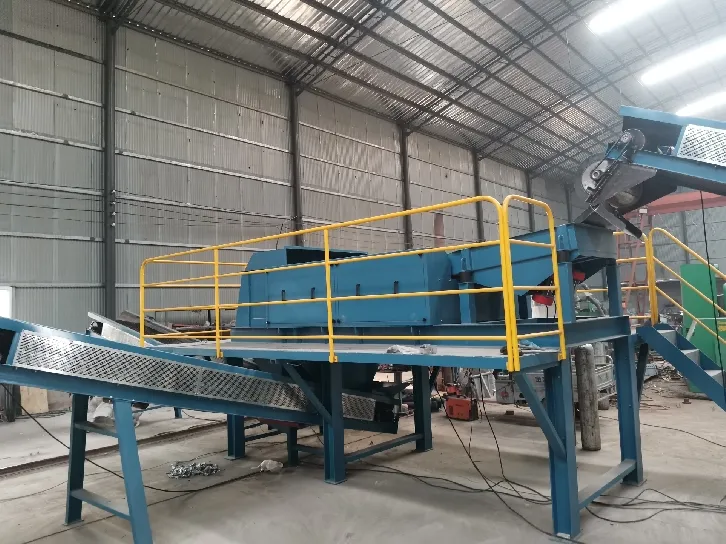

11月 . 26, 2024 22:49 Back to list
Cost Considerations for a Metal Recycling Plant An Overview
Metal recycling has emerged as a vital industry in the modern economy, addressing environmental concerns while reducing the demand for virgin materials. As the world becomes more conscious about sustainability and resource conservation, setting up a metal recycling plant can be a lucrative venture. However, it is crucial to understand the various costs associated with establishing and operating such a facility.
Initial Capital Investment
The initial capital investment is a significant factor when considering the establishment of a metal recycling plant. This includes costs associated with land acquisition, construction, machinery, and equipment. The size and scale of the operation greatly influence the overall investment. For instance, small-scale facilities might require $300,000 to $500,000, whereas larger operations could necessitate several million dollars.
Land and Facility Costs
Finding a suitable location for a recycling plant is essential. The site should be accessible to suppliers of scrap metal and have adequate space for operations, storage, and potential expansion. Property costs vary significantly depending on the region, but purchasing or leasing land can account for a considerable portion of the initial investment. Additionally, constructing the physical plant must meet zoning and environmental regulations, which can incur additional costs.
Machinery and Equipment Expenses
The machinery and equipment required for a metal recycling plant are among the most significant investments. These include shredders, balers, shears, and various conveyor systems designed for sorting and processing metals. The cost of this equipment can range from $200,000 for smaller operations to over $5 million for large, fully equipped facilities. Investing in advanced technology can improve efficiency and reduce operational costs in the long run, making it a crucial decision in the planning phase.
Operating Costs

Once the plant is established, ongoing operational costs must be considered. These expenses generally include labor, utilities, maintenance, insurance, and transportation. Labor costs can vary based on regional wage rates, the number of employees, and the levels of expertise required for operating machinery. Utilities such as electricity and water are critical, especially in a process-intensive industry like metal recycling.
Permitting and Environmental Compliance
Another significant cost consideration involves securing the necessary permits and adhering to environmental regulations. The recycling industry is heavily regulated to minimize environmental impact, and failing to comply can result in fines or shutdowns. It is vital to invest time and resources in understanding the legal requirements for operating a recycling facility, which may include air and water quality permits, waste management plans, and safety protocols.
Market Fluctuations and Economic Factors
The profitability of metal recycling plants is closely tied to market conditions. The prices for recycled metals fluctuate based on global demand and supply dynamics, which can impact revenue. During economic downturns, the demand for recycled materials may decrease, leading to lower prices and revenue streams. As a result, it is crucial to conduct thorough market research and analysis to create a solid business plan that accounts for such fluctuations.
Financing Options
Considering the high cost of setting up and operating a metal recycling plant, exploring various financing options is essential. Operators can seek loans, grants, or investment from private equity. Additionally, collaborating with organizations focused on sustainability may provide financial incentives or support for establishing eco-friendly operations.
Conclusion
In summary, the cost of starting and running a metal recycling plant encompasses various factors, including initial capital investment, operating expenses, and compliance with regulatory requirements. While the industry presents significant opportunities for profit and environmental impact, careful planning and research are vital to navigate the complexities involved. Potential investors and operators should be prepared for a dynamic market and remain adaptable to ensure long-term sustainability and success in the metal recycling sector. As society continues to prioritize recycling and sustainable practices, those willing to embrace the challenges will find that the rewards of operating a metal recycling plant extend beyond mere profit, contributing to a healthier planet.
Latest news
Troubleshooting Common Eddy Separator Problems
NewsJul.04,2025
The Role of Metal Recycling Plants in Circular Economy
NewsJul.04,2025
The Impact of Recycling Line Pickers on Waste Management Costs
NewsJul.04,2025
Safety Features Every Metal Shredder Should Have
NewsJul.04,2025
How Industrial Shredders Improve Waste Management Systems
NewsJul.04,2025
How Cable Granulators Contribute to Sustainable Recycling
NewsJul.04,2025